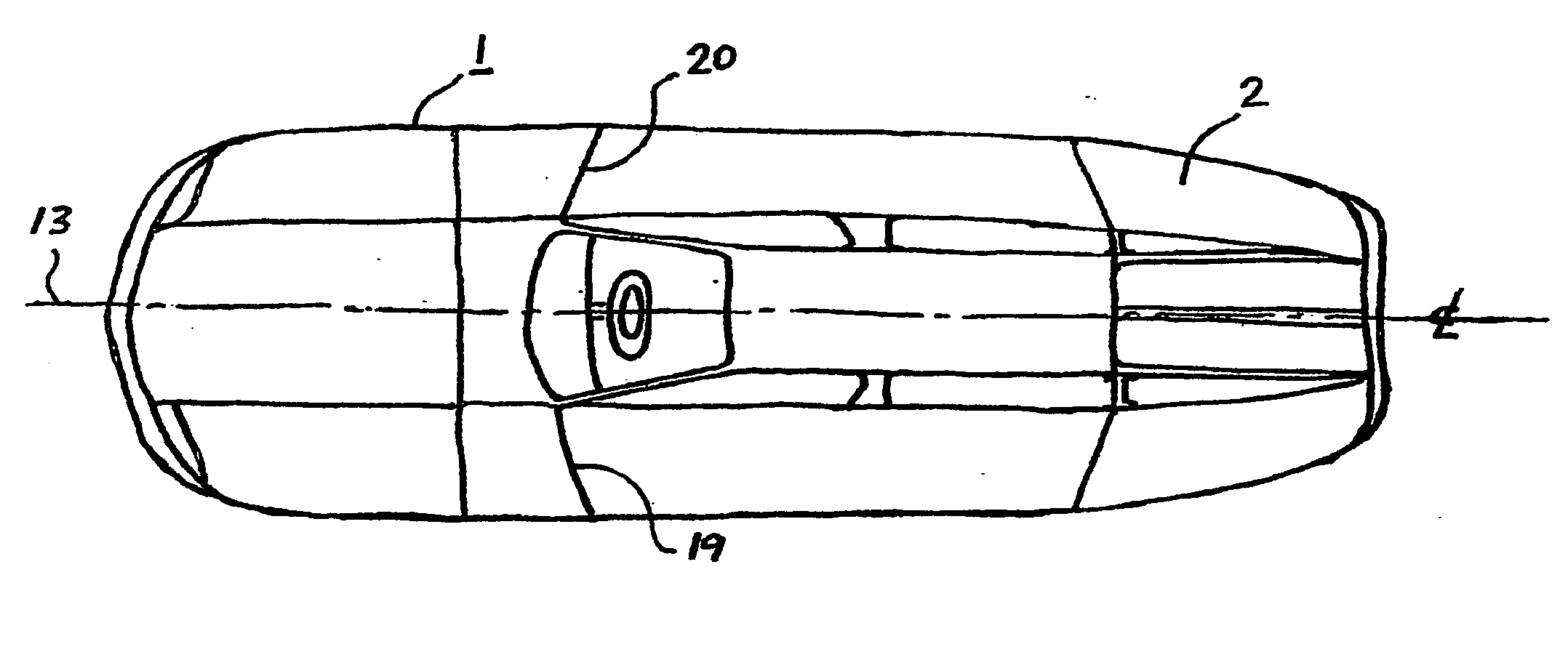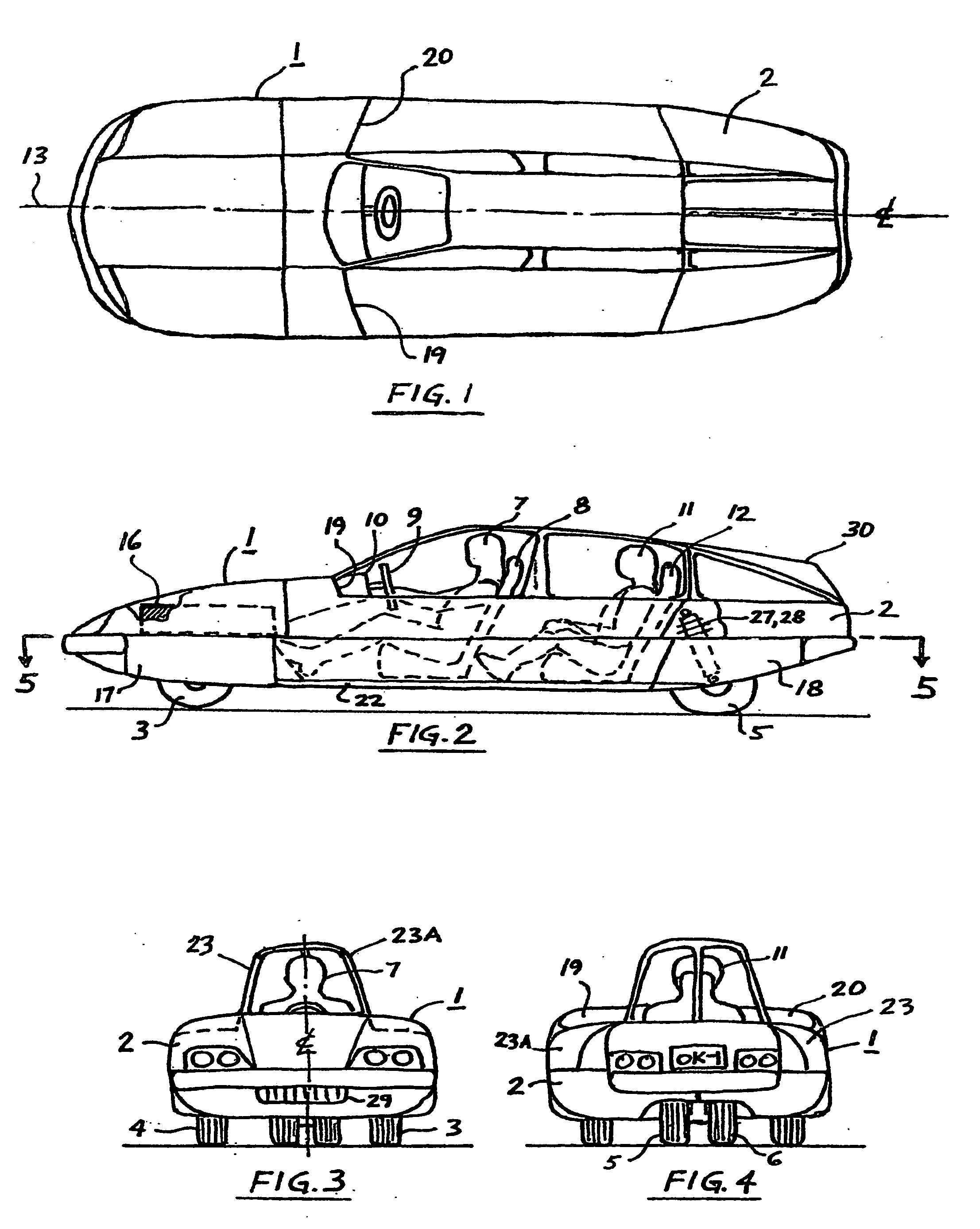The battery packs for electric vehicles have usually been located in the front or back of the vehicle, which unfavorably affects the center of gravity and vehicle handling, or in some instances, the battery packs have been mounted on the centerline of the vehicle in a tunnel.
GB Patent #2,254,055 of Bothwell discloses a four wheeled vehicle with tandem seating of the two passengers, but does not teach location of batteries or
fuel cells in lower side compartments, lengthwise between the wheels, outside of the passenger compartment.
Large
electric vehicle batteries in this location would adversely
impact center of gravity and steering of the vehicle.
JP-6-156316 patent of Suzuki teaches an electric automobile having tandem seating of the passengers, but clearly shows less aerodynamic vehicle with location of batteries under the rear seat—(not on sides), which results in larger (higher) frontal area, increased drag, reduced safety of the driver during frontal
impact and an unstable vehicle with the center of gravity close to the rear wheels.
Patterson does not teach anything about streamlining of the mirrors and air drag reduction, and provides very limited rear
view angle due to the narrowness of his mirror, and the rear part of the window frame is obstructing the view directly rearward.
U.S. Pat. No. 2,757,018 of Galla teaches a hinged
fender skirt covering the rear wheel, but does not teach top hinged panels covering the front wheels.
The front wheels of Galla's conventional vehicle protrude from the body during steering and thus would interfere with the front panels.
It would not be obvious to use
honeycomb in the sides of the vehicle, because Jensen's vehicle does not provide for thick sides because it does not have low side batteries and tandem seating of the passengers.
There is no reason to add thickness of Jensen's vehicle side, since it would only increase the air drag and weight.
Structural body panels usually have a
glass fiber reinforcement, which makes them heavy.
Spacecraft structures sometimes use welded
magnesium extrusions, which are expensive due to requirement of special
inert atmosphere for
welding, the need for complex
welding fixtures and heat treatment after welding to relieve stress in the structure.
Janotik also does not teach a vehicle
body frame made of
magnesium alloy, and uses an
adhesive in combination with crimping to join together only frame subassemblies, not all individual elements.
U.S. Pat. No. 3,617,364 of Jarema discloses a plastic layer on a foam core, but does not teach composite sandwich construction of body panel with a
metal foam core.
The prior art electrical vehicles often have
high pressure air filled tires, which can
blow out and cause accidents.
Since the electric motors used in prior art vehicles do not generate appreciable quantities of heat and because the use of
electricity for heating and cooling of the vehicle passenger compartment may be impractical due to the
high energy drain on the batteries, prior art electric vehicles use auxiliary
gasoline, diesel or
kerosene fueled heating / cooling systems, but these systems continue
pollution of the
atmosphere and defeat the non-
pollution purpose of electric vehicles.
In addition, prior art electric vehicles have very limited ranges, not only because of their
body weight and high drag, but also because they utilize low
specific energy density batteries.
Dufour does not teach non-polluting,
hydrogen generating
system which is consuming only water, or only water and
hydrogen.
Such system would be also too heavy and bulky, thus limiting the range and would be difficult to seal in a vehicle.
However, all prior art reactor systems produce a
waste material which must be disposed of, and are dangerous to
handle due to highly flammable hydrides when exposed to
moisture or moist air.
There is also virtually no infrastructure available for these
metal hydrides.
 Login to View More
Login to View More  Login to View More
Login to View More 


